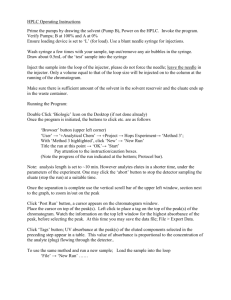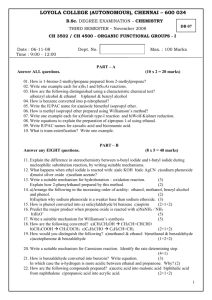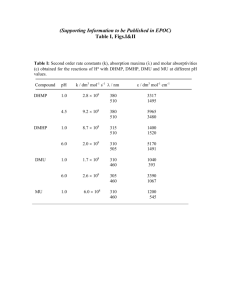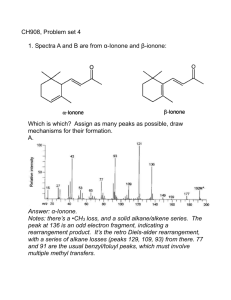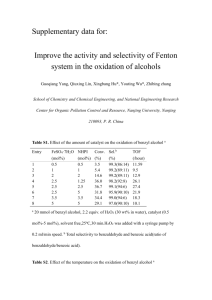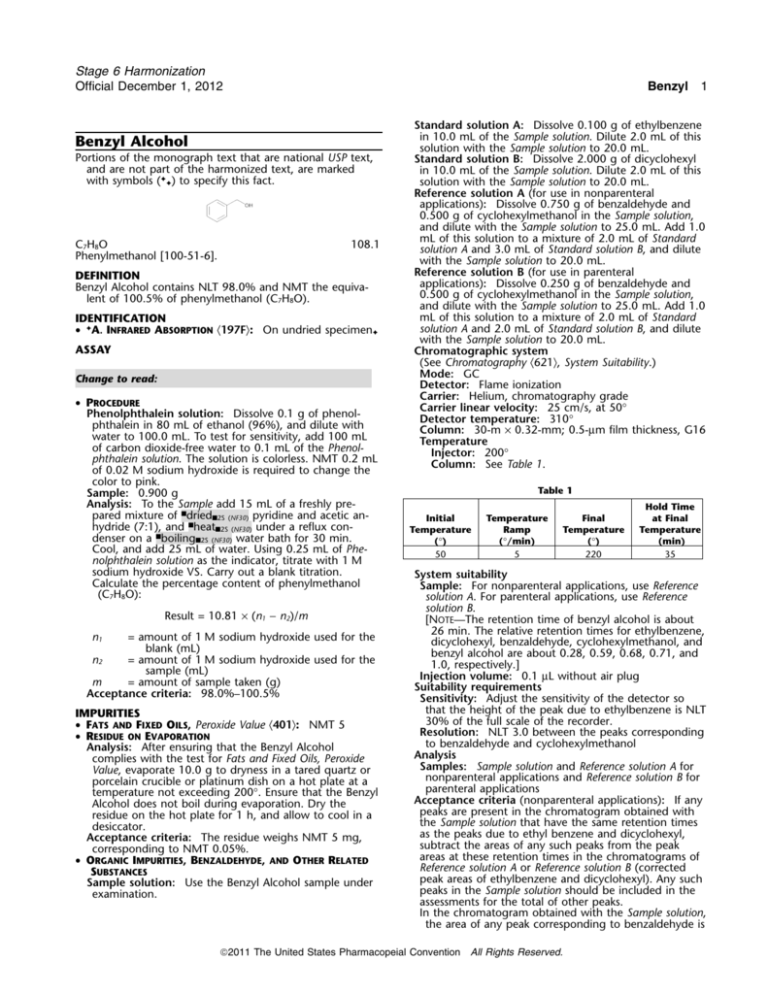
Stage 6 Harmonization
Official December 1, 2012
Benzyl
.
Benzyl Alcohol
Portions of the monograph text that are national USP text,
and are not part of the harmonized text, are marked
with symbols (✦✦) to specify this fact.
C7H8O
Phenylmethanol [100-51-6].
108.1
DEFINITION
Benzyl Alcohol contains NLT 98.0% and NMT the equivalent of 100.5% of phenylmethanol (C7H8O).
IDENTIFICATION
• ✦A. INFRARED ABSORPTION ⟨197F⟩: On undried specimen✦
ASSAY
Change to read:
• PROCEDURE
Phenolphthalein solution: Dissolve 0.1 g of phenolphthalein in 80 mL of ethanol (96%), and dilute with
water to 100.0 mL. To test for sensitivity, add 100 mL
of carbon dioxide-free water to 0.1 mL of the Phenolphthalein solution. The solution is colorless. NMT 0.2 mL
of 0.02 M sodium hydroxide is required to change the
color to pink.
Sample: 0.900 g
Analysis: To the Sample add 15 mL of a freshly prepared mixture of ■dried■2S (NF30) pyridine and acetic anhydride (7:1), and ■heat■2S (NF30) under a reflux condenser on a ■boiling■2S (NF30) water bath for 30 min.
Cool, and add 25 mL of water. Using 0.25 mL of Phenolphthalein solution as the indicator, titrate with 1 M
sodium hydroxide VS. Carry out a blank titration.
Calculate the percentage content of phenylmethanol
(C7H8O):
Result = 10.81 × (n1 − n2)/m
n1
= amount of 1 M sodium hydroxide used for the
blank (mL)
n2
= amount of 1 M sodium hydroxide used for the
sample (mL)
m
= amount of sample taken (g)
Acceptance criteria: 98.0%–100.5%
IMPURITIES
• FATS AND FIXED OILS, Peroxide Value ⟨401⟩: NMT 5
• RESIDUE ON EVAPORATION
Analysis: After ensuring that the Benzyl Alcohol
complies with the test for Fats and Fixed Oils, Peroxide
Value, evaporate 10.0 g to dryness in a tared quartz or
porcelain crucible or platinum dish on a hot plate at a
temperature not exceeding 200°. Ensure that the Benzyl
Alcohol does not boil during evaporation. Dry the
residue on the hot plate for 1 h, and allow to cool in a
desiccator.
Acceptance criteria: The residue weighs NMT 5 mg,
corresponding to NMT 0.05%.
• ORGANIC IMPURITIES, BENZALDEHYDE, AND OTHER RELATED
SUBSTANCES
Sample solution: Use the Benzyl Alcohol sample under
examination.
1
Standard solution A: Dissolve 0.100 g of ethylbenzene
in 10.0 mL of the Sample solution. Dilute 2.0 mL of this
solution with the Sample solution to 20.0 mL.
Standard solution B: Dissolve 2.000 g of dicyclohexyl
in 10.0 mL of the Sample solution. Dilute 2.0 mL of this
solution with the Sample solution to 20.0 mL.
Reference solution A (for use in nonparenteral
applications): Dissolve 0.750 g of benzaldehyde and
0.500 g of cyclohexylmethanol in the Sample solution,
and dilute with the Sample solution to 25.0 mL. Add 1.0
mL of this solution to a mixture of 2.0 mL of Standard
solution A and 3.0 mL of Standard solution B, and dilute
with the Sample solution to 20.0 mL.
Reference solution B (for use in parenteral
applications): Dissolve 0.250 g of benzaldehyde and
0.500 g of cyclohexylmethanol in the Sample solution,
and dilute with the Sample solution to 25.0 mL. Add 1.0
mL of this solution to a mixture of 2.0 mL of Standard
solution A and 2.0 mL of Standard solution B, and dilute
with the Sample solution to 20.0 mL.
Chromatographic system
(See Chromatography ⟨621⟩, System Suitability.)
Mode: GC
Detector: Flame ionization
Carrier: Helium, chromatography grade
Carrier linear velocity: 25 cm/s, at 50°
Detector temperature: 310°
Column: 30-m × 0.32-mm; 0.5-µm film thickness, G16
Temperature
Injector: 200°
Column: See Table 1.
Table 1
Initial
Temperature
(°)
50
Temperature
Ramp
(°/min)
5
Final
Temperature
(°)
220
Hold Time
at Final
Temperature
(min)
35
System suitability
Sample: For nonparenteral applications, use Reference
solution A. For parenteral applications, use Reference
solution B.
[NOTE—The retention time of benzyl alcohol is about
26 min. The relative retention times for ethylbenzene,
dicyclohexyl, benzaldehyde, cyclohexylmethanol, and
benzyl alcohol are about 0.28, 0.59, 0.68, 0.71, and
1.0, respectively.]
Injection volume: 0.1 µL without air plug
Suitability requirements
Sensitivity: Adjust the sensitivity of the detector so
that the height of the peak due to ethylbenzene is NLT
30% of the full scale of the recorder.
Resolution: NLT 3.0 between the peaks corresponding
to benzaldehyde and cyclohexylmethanol
Analysis
Samples: Sample solution and Reference solution A for
nonparenteral applications and Reference solution B for
parenteral applications
Acceptance criteria (nonparenteral applications): If any
peaks are present in the chromatogram obtained with
the Sample solution that have the same retention times
as the peaks due to ethyl benzene and dicyclohexyl,
subtract the areas of any such peaks from the peak
areas at these retention times in the chromatograms of
Reference solution A or Reference solution B (corrected
peak areas of ethylbenzene and dicyclohexyl). Any such
peaks in the Sample solution should be included in the
assessments for the total of other peaks.
In the chromatogram obtained with the Sample solution,
the area of any peak corresponding to benzaldehyde is
2011 The United States Pharmacopeial Convention All Rights Reserved.
2
Stage 6 Harmonization
Official December 1, 2012
Benzyl
NMT the difference between the area of the peak due
to benzaldehyde in the chromatogram obtained with
Reference solution A (0.15%) and the area of the peak
due to benzaldehyde in the chromatogram obtained
with the Sample solution.
In the chromatogram obtained with the Sample solution,
the area of any peak corresponding to
cyclohexylmethanol is NMT the difference between the
area of the peak due to cyclohexylmethanol in the
chromatogram obtained with Reference solution A
(0.10%) and the area of the peak due to
cyclohexylmethanol in the chromatogram obtained
with the Sample solution.
In the chromatogram obtained with the Sample solution,
the sum of the areas of any peak with a relative
retention time less than that of benzyl alcohol and
apart from the peaks due to benzaldehyde and
cyclohexylmethanol is NMT four times the area of
ethylbenzene in Reference solution A, corrected if
necessary as described above (0.04%).
In the chromatogram obtained with the Sample solution,
the sum of the areas of any peak with a relative
retention time greater than that of benzyl alcohol is
NMT the area of dicyclohexyl in Reference solution A,
corrected if necessary as described above (0.3%).
Disregard any peak with an area less than 0.01 times
that of the peak due to ethylbenzene in the
chromatogram of Reference solution A, corrected if
necessary as described above.
Acceptance criteria (parenteral applications): If any
peaks are present in the chromatogram obtained with
the Sample solution that have the same retention times
as the peaks due to ethyl benzene and dicyclohexyl,
subtract the areas of any such peaks from the peak
areas at these retention times in the chromatograms of
Reference solution A or Reference solution B (corrected
peak areas of ethylbenzene and dicyclohexyl). Any such
peaks in the Sample solution should be included in the
assessments for the total of other peaks.
In the chromatogram obtained with the Sample solution,
the area of any peak corresponding to benzaldehyde is
NMT the difference between the area of the peak due
to benzaldehyde in the chromatogram obtained with
Reference solution B (0.05%) and the area of the peak
due to benzaldehyde in the chromatogram obtained
with the Sample solution.
In the chromatogram obtained with the Sample solution,
the area of any peak corresponding to
cyclohexylmethanol is NMT the difference between the
area of the peak due to cyclohexylmethanol in the
chromatogram obtained with Reference solution B
(0.10%) and the area of the peak due to
cyclohexylmethanol in the chromatogram obtained
with the Sample solution.
In the chromatogram obtained with the Sample solution,
the sum of the areas of any peak with a relative
retention time less than that of benzyl alcohol and
apart from the peaks due to benzaldehyde and
cyclohexylmethanol is NMT two times the area of
ethylbenzene in Reference solution B, corrected if
necessary as described above (0.02%).
In the chromatogram obtained with the Sample solution,
the sum of the areas of any peak with a relative
retention time greater than that of benzyl alcohol is
NMT the area of dicyclohexyl in Reference solution B,
corrected if necessary as described above (0.2%).
Disregard any peak with an area less than 0.01 times
that of the peak due to ethylbenzene in the
chromatogram of Reference solution B, corrected if
necessary as described above.
SPECIFIC TESTS
• ACIDITY
Phenolphthalein solution: Prepare as directed in the
Assay.
Analysis: To 10 mL of Benzyl Alcohol add 10 mL of
ethanol (96%) and 1 mL of Phenolphthalein solution.
Acceptance criteria: NMT 1 mL of 0.1 M sodium
hydroxide is required to change the color of the
indicator to pink.
• ✦CLARITY OF SOLUTION
[NOTE—The Sample solution is to be compared to
Reference suspension 1 in diffused daylight 5 min after
preparation of Reference suspension 1.]
Hydrazine solution: Transfer 1.0 g of hydrazine sulfate
to a 100-mL volumetric flask, dissolve in and dilute with
water to volume, and mix. Allow to stand 4–6 h before
use.
Methenamine solution: Transfer 2.5 g of methenamine
to a 100-mL glass-stoppered flask, add 25.0 mL of
water, insert the glass stopper, and mix to dissolve.
Primary opalescent suspension: [NOTE—This
suspension is stable for 2 months, provided it is stored
in a glass container free from surface defects. The
suspension must not adhere to the glass and must be
well mixed before use.] Transfer 25.0 mL of Hydrazine
solution to the Methenamine solution in the 100-mL
glass-stoppered flask. Mix, and allow to stand for 24 h.
Opalescence standard: [NOTE—This suspension should
not be used beyond 24 h after preparation.] Transfer
15.0 mL of the Primary opalescent suspension to a 1000mL volumetric flask, dilute with water to volume, and
mix.
Reference suspension 1: Transfer 5.0 mL of the
Opalescence standard to a 100-mL volumetric flask, and
dilute with water to volume.
Reference suspension 2: Transfer 10.0 mL of the
Opalescence standard to a second 100-mL volumetric
flask, and dilute with water to volume.
Sample solution: Dissolve 2.0 g of Benzyl Alcohol in 60
mL of water.
Analysis: Transfer a sufficient portion of the Sample
solution to a test tube of colorless, transparent, neutral
glass with a flat base and an internal diameter of 15–25
mm, to obtain a depth of 40 mm. Similarly transfer
portions of Reference suspension 1, Reference suspension
2, and water to separate matching test tubes. Compare
the Sample solution, Reference suspension 1, Reference
suspension 2, and water in diffused daylight, viewing
vertically against a black background (see
Spectrophotometry and Light-Scattering ⟨851⟩, Visual
Comparison). [NOTE—The diffusion of light must be such
that Reference suspension 1 can readily be distinguished
from water, and that Reference suspension 2 can readily
be distinguished from Reference suspension 1.]
Acceptance criteria: The Sample solution shows the
same clarity as that of water, or its opalescence is not
more pronounced than that of Reference suspension 1.✦
• ✦COLOR OF SOLUTION
Sample solution: Use the Sample solution prepared in
the test for Clarity of Solution.
Analysis: Transfer a sufficient portion of the Sample
solution to a test tube of colorless, transparent, neutral
glass with a flat base and an internal diameter of 15–25
mm, to obtain a depth of 40 mm. Similarly transfer a
portion of water to a separate matching test tube.
Compare the color of the Sample solution with that of
water in diffused daylight, viewing vertically against a
white background (see Spectrophotometry and LightScattering ⟨851⟩, Visual Comparison).
Acceptance criteria: The Sample solution has the color
of water.✦
2011 The United States Pharmacopeial Convention All Rights Reserved.
Stage 6 Harmonization
Official December 1, 2012
• REFRACTIVE INDEX ⟨831⟩: 1.538–1.541 at 20°
ADDITIONAL REQUIREMENTS
• ✦LABELING: Where Benzyl Alcohol is intended for use in
the manufacture of parenteral applications, it is so
labeled.✦
• ✦PACKAGING AND STORAGE: Preserve in tight containers,
protected from light.✦
Benzyl
• ✦USP REFERENCE STANDARDS
USP Benzyl Alcohol RS✦
2011 The United States Pharmacopeial Convention All Rights Reserved.
3


